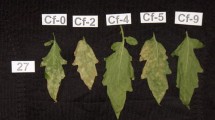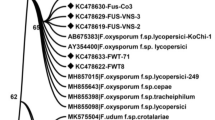Abstract
Leaf mould (Passalora fulva) has emerged as an important disease of greenhouse-growing tomato crops in Croatia during the last decade. In order to establish sustainable control measures, the presence of P. fulva races was investigated, in vitro sensitivity of the fungus to several fungicidal products was tested, and susceptibility of some old tomato varieties was checked. Seventeen isolates were collected from different parts of Croatia and inoculated on tomato cv. ‘Moneymaker’ differentials with different resistance genes (Cf-2, Cf-4, Cf-5 and Cf-9) or without resistance genes (Cf-0). Based on symptoms appearance assessment, 11 isolates were determined as P. fulva race 2, two isolates as race 5, one isolate as race 2.5 and three isolate as race 0. Sequence analysis of the Avr2 gene of five P. fulva race 2 isolates showed and insertion of adenine at 117_119 bp compared to the reference Avr2 wild-type gene retrieved from GenBank®, which leads to amino acid change from Tyrosine to Valine (p. Tyr41ValfsX1) in Avr2 protein. Pathogenicity tests with a P. fulva race 2 isolate on seven old tomato varieties lead to the development of leaf mould symptoms on four of seven varieties. Sensitivity of a selected P. fulva race 2 isolate was examined on agar plates amended with four fungicides products which were authorized in Croatia at that time for control different diseases on tomato. According to the results, Signum® was significantly and constantly the most effective product across all assessment periods.



Similar content being viewed by others
References
Altin N (2016) Identification of race 2.5 of leaf mold (Passalora fulva, syn. Cladosporium fulvum) on tomato. J Plant Dis Protect 123(6):279–284. https://doi.org/10.1007/s41348-016-0040-1
Briceño EX, Lattore BA (2007) Outbreaks of Cladosporium rot associated with delayed harvest wine grapes in Chile. Plant Dis 91(8):1060
Crous PW (2009) Taxonomy and phylogeny of the genus Mycosphaerella and its anamorphs. Fung Divers 38:1–24
De Wit PJGM (1977) A light and scanning-electron microscopic study of infection of tomato plants by virulent and avirulent races of Cladosporium fulvum. Neth J Plant Pathol 83(3):109–122
De Wit PJGM (1992) Molecular characterization of gene-for-gene systems in plant-fungus interactions and the application of avirulence genes in control of plant pathogens. Annu Rev Phytopathol 30:391–418
Enya J, Ikeda K, Takeuchi T, Horikoshi N, Higashi T, Sakai T, Iida Y, Nishi K, Kubota M (2009) The first occurrence of leaf mold of tomato caused by races 4.9 and 4.9.11 of Passalora fulva (syn. Fulvia fulva) in Japan. J Gen Plant Pathol 75(1):76–79. https://doi.org/10.1007/s10327-008-0134-0
Flor HH (1971) Current status of the gene-for-gene concept. Annu Rev Phytopathol 9:275–296. https://doi.org/10.1146/annurev.py.09.090171.001423
Gleason ML, Parker SK (1995) Epidemic of leaf mold caused by Fulvia fulva on field-grown tomatoes in Iowa. Plant Dis 76(5):538
Hammond-Kosack KE, Jones JDG (1994) Incomplete dominance of tomato Cf genes for resistance to Cladosporium fulvum. Mol Plant Microbe Interact 7(1):58–70
Holliday P, Mulder JL (1976) Fulvia fulva. CMI Descriptions of Pathogenic Fungi and Bacteria, No. 487. Commonwealth Mycological Institute, Kew, Surrey, UK
Iida Y, van’t Hof P, Beenen H, Mesarich C, Kubota M, Stergiopoulos I, et al (2015) Novel mutations detected in avirulence genes overcoming tomato Cf resistance genes in isolates of a Japanese population of Cladosporium fulvum. PLoS ONE 10(4):e0123271. https://doi.org/10.1371/journal.pone.0123271
Jones DA, Dickinson MJ, Balint-Kurti PJ, Dixon MS, Jones JDG (1993) Two complex resistance loci revealed in tomato by classical and RFLP mapping of the Cf-2, Cf-4, Cf-5 and Cf-9 genes for resistance to Cladosporium fulvum. Mol Plant Microbe Interact 6(3):348–357
Joosten MHAJ, De Wit PJGM (1988) Isolation, purification and preliminary characterization of a protein specific for compatible Cladosporium fulvum (syn. Fulvia fulva)–tomato interactions. Physiol Mol Plant Pathol 33(2):241–253
Joosten MHAJ, De Wit PJGM (1999) The tomato-Cladosporium fulvum interaction: a versatile experimental system to study plan–pathogen interactions. Annu Rev Phytopathol 37:335–367
Joosten MHAJ, Vogelsang R, Cozijnsen TJ, Verberne MC, De Wit PJGM (1997) The biotrophic fungus Cladosporium fulvum circumvents Cf-4-mediated resistance by producing unstable AVR4 elicitors. Plant Cell 9(3):367–379
Latorre BA, Besoain X (2002) Occurrence of severe outbreaks of leaf mold caused by Fulvia fulva in greenhouse tomatoes in Chile. Plant Dis 86(6):694
Lazarovits G, Higgins VJ (1976) Ultrastructure of susceptible, resistant, and immune reactions of tomato to races of Cladosporium fulvum. Can J Bot 54(3–4):235–249
Lee JH, Park MS, Kim JC, Jang KS, Choi YH, Kim HT, Choi GJ (2013) Occurrence of leaf mold pathogen Fulvia fulva isolates infecting tomato Cf-9 cultivars in Korea. Korean J Horticult Sci Technol 31(6):740–747
Luderer R, Takken FLW, De Wit PJGM, Joosten MHAJ (2002) Cladosporium fulvum overcomes Cf-2-mediated resistance by producing truncated AVR2 elicitor proteins. Mol Microbiol 45(3):875–884
Medina R, López SMY, Franco MEE, Rollan C, Ronco BL, Saparrat MCN, De Wit PJGM, Balatti PA (2015) A survey on occurrence of Cladosporium fulvum identifies race 0 and race 2 in tomato-growing areas of Argentina. Plant Dis 99(12):1732–1737
Norton J (1914) Resistance to Cladosporium fulvum in tomato varieties. Phytopathology 4:398
Novak A, Miličević T (2010) Occurrence and severity of tomato leaf mould caused by fungus Passalora fulva in Croatia. AgronomskiGlasnik 72:27–38
Panjan M (1963) Tomato leaf mould (Cladosporium fulvum). Biljnazaštita 6–7:129–130
Satou M, Shinozaki T, Nishi K, Kubota M (2005) Leaf mold of tomato caused by races 4 and 4.11 of Passalora fulva in Japan. J Gen Plant Pathol 71(6):436–437
Serey RA, Torres R, Lattore BA (2007) Pre- and post-infection activity of new fungicides against Botrytis cinerea and other fungi causing decay of table grapes. Ciencia e Investig Agraria 34(3):215–224
Stergiopoulos I, De Kock MJD, Lindhout P, De Wit PJGM (2007) Allelic variation in the effector genes of the tomato pathogen Cladosporium fulvum reveals different modes of adaptive evolution. Mol Plant Microbe Interact 20(10):1271–1283
Šubić M, Cvjetković B (2002) Tomato leaf mould (Fulvia fulva (Cooke) Cif. = Cladosporium fulvum Cooke). GlasiloBiljneZaštite 5:298–303
Thomma BPHJ, Peter Van Esse H, Crous PW, De Wit PJGM (2005) Cladosporium fulvum (syn. Passalora fulva), a highly specialized plant pathogen as a model for functional studies on plant pathogenic Mycosphaerellaceae. Mol Plant Pathol 6(4):379–393
Van der Ackerveken GFJM, Van Kan JAL, De Wit PJGM (1992) Molecular analysis of the avirulence gene Avr9 of the fungal pathogen Cladosporium fulvum fully supports the gene-for-gene hypothesis. Plant J 2(3):359–366
Van Kan JAL, Joosten MHAJ, Wagemakers CAM, Van der Berg-Velthuis GCM, De Wit PJGM (1992) Differential accumulation of mRNAs encoding extracellular and intracellular PR proteins in tomato induced by virulent and avirulent races of Cladosporium fulvum. Plant Mol Biol 20(3):513–527
Veloukas T, Bardas GA, Karaoglanidis GS, Tzavella-Klonari K (2007) Management of tomato leaf mould caused by Cladosporium fulvumwith trifloxystrobin. Crop Protect 26(6):845–851
Westerink N, Brandwagt BF, De Wit PJGM, Joosten MHAJ (2004) Cladosporium fulvum circumvents the second functional resistance gene homologue at the Cf-4locus (Hcr9-4E) by secretion of a stable Avr4E isoform. Mol Microbiol 54(2):533–545
Author information
Authors and Affiliations
Corresponding author
Additional information
Publisher's Note
Springer Nature remains neutral with regard to jurisdictional claims in published maps and institutional affiliations.
Rights and permissions
About this article
Cite this article
Novak, A., Ćosić, J., Vrandečić, K. et al. Characterization of tomato leaf mould pathogen, Passalora fulva, in Croatia. J Plant Dis Prot 128, 1041–1049 (2021). https://doi.org/10.1007/s41348-020-00419-6
Received:
Accepted:
Published:
Issue Date:
DOI: https://doi.org/10.1007/s41348-020-00419-6




